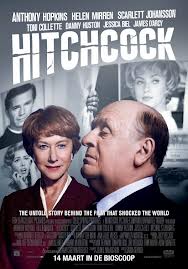

"What if someone good made a horror picture?" asks Alfred Hitchcock of his wife Alma Reville early on in Sacha Gervasi's clever and witty drama about the making of Psycho. Psycho was itself the film that so emphatically answered that question in 1960 and the story of its creation – based on Stephen Rebello's enthralling 1990 account, Alfred Hitchcock and the Making of Psycho, and scripted by John McLaughlin – is at heart the story of a marriage, between a fat, ugly genius and the "tiny, birdlike woman" who was invigilator, confidante and touchstone to his talent.
Played here by Anthony Hopkins, in facial prosthesis and fake belly, and the neither tiny nor particularly birdlike Helen Mirren, Hitch and Alma appear as an indissoluble partnership in art and life, suddenly threatened by pressures from without (no budget) but more from within, particularly by Alfred's tendency, now tiresome to the red-haired Alma, to become obsessed with his leading blondes.
The film opens with Hitchcock speaking directly to us, Alfred Hitchcock Presents … style. He's just enjoyed the huge success of North by Northwest and is at a loose end for projects. Offered Cary Grant in Casino Royale, he reminds his assistant Peggy Robertson (Toni Collette): "I just made that movie." His ears prick up, however, when he encounters Robert Bloch's Freudian gore-transvestite-incest-necrophilia shocker Psycho, which horrifies everyone he shows it to, but which might give him the edge he needs in his private war with French director Henri-Georges Clouzot, whose Les Diaboliques has critics talking of "French Hitchcocks" and similar rot.
But Paramount won't back it, and the Hitchcocks are driven back on their own resources, and into one another's company. We see them in domestic harmony, 34 years married, Alfred in the bath reading the Times, and Alma clad in the same white bra and slip that Janet Leigh will wear in Psycho's opening sequence. Alma has the epicurean Hitchcock on a diet and one senses trouble in paradise. The film essentially tells us how their marriage suffers until she, in a magisterial, bark-stripping tirade, finally reminds him of her indispensable role in his success: "I was once your boss!"
The device that speeds along the estrangement of the partnership is the movie's weakest invention, a screenwriting project with another writer (Danny Huston), a fool and a hack in Hitch's eyes. But one should treat that like a McGuffin – a plot engine – forget that the middle section sags a little, and enjoy the ride. The making of Psycho is depicted in detail without our seeing one frame of the completed movie. The closest we come is when Hitchcock stands in the lobby outside the premiere, faux-conducting Bernard Hermann's slashing violins; he has a combination of a maestro's manual flourishes and a murderer's manic stabbing motions as the audience inside wails and howls its way through the shower scene. It's a magnificent moment for anyone who can blink-sync their way through those infamous 45 seconds, and beautifully brought off by Hopkins, who hasn't had this much fun in years.
All the smaller roles are neatly filled, particularly Scarlett Johansson's Leigh and James Darcy's Tony Perkins, the latter almost eerily resembling the original; plus Kurtwood Smith as the fuming head of the censor's office and Ralph Macchio as screenwriter Joseph Stephano. But it lives and breathes through Hopkins and Mirren. Unlike Toby Jones's Hitch in The Girl, which physically and vocally evoked the director very convincingly, Hopkins relies, as with his Nixon, on a few tics, some prosthetic fakery, and just lives the man, pink, pale, blinking and blimpish, held up by iron certainty in his own talents.
Mirren matches him, though, despite a slightly thankless and less rounded role to which she brings all her heft and leverage; finally, however, she is the film's – hell, both films' – secret heroine. Forget all those blondes – count on the redhead.



導演希區考克在一九六○年拍出了影史經典《驚魂記》,歷經半世紀仍魅力不減。但穿梭時光隧道回到籌拍當時,這部片既不受派拉蒙片廠看好,又歷經電檢處刁難,最後根本是希區考克自掏腰包出資拍攝。這些鮮為人知的幕後紀實,都呈現在劇作家史帝芬˙瑞貝羅(Stephen Rebello)的《驚悚大師希區考克:重返驚魂記》書中。
《驚悚大師希區考克》早在一九九○年問世,瑞貝羅訪問了希區考克與《驚魂記》的演員、編劇、劇組工作人員,重現《驚魂記》從原著改編到拍攝、上映等生動細節。二○一二年好萊塢根據這本書拍成電影《驚悚大師:希區考克》,由安東尼˙霍普金斯詮釋希區考克,片子今年四月將在台上映。
「一九五九年春天,只要希區考克肥短的手指輕輕一彈,整個電影界就會為之震盪。」瑞貝羅精準描述出當年六十歲、拍過四十六部電影的希區考克在影壇的崇高地位。不過,大導演此刻也正陷入尋找題材受挫的困難,也對合作的詹姆斯˙史都華(James Stewart)等大牌明星調漲片酬的要求抱怨不已,直到剛出版的小說《驚魂記》送進他的辦公室,希區考克又燃起創作的欲望。
驚悚小說家羅伯˙布洛克根據當時發生在威斯康辛州駭人聽聞的凶殺案件,寫成《驚魂記》,描寫戀母變裝癖的凶手,假扮成死去的母親連續殺人。
這一幕在片中僅出現四十六秒,卻變換了六十多個鏡位,後來確實成了《驚魂記》的經典。從蓮蓬頭噴水、人影刀影、驚聲尖叫到混合著鮮血的水流,鏡頭完全沒出現刀尖刺入身體的畫面,卻營造出無比驚悚氣氛,搭配伯納德˙赫曼作曲的提琴拉鋸聲響,嚇壞了整個戲院的觀眾。
書中重現當時拍攝這幕戲的過程,希區考克委請視覺設計師沙沃˙巴斯畫出這部分的腳本,為避免太過暴力被電檢處找麻煩,而以不連續畫面處理,造就了這場戲著名的蒙太奇快速手法。但關於這場戲究竟是希區考克還是巴斯執導,後來卻成了各說各話的一樁公案。
化妝師力挺希區考克說:「他導戲看來漫不經心,好像什麼也沒作……但是他那雙眼可不會錯失大小事。」巴斯則高調表示:「當眾人回顧這部電影時,你不會知道,這幾場該死的戲其實是這個小伙子努力做出來的……不管我做了哪些,整部片子都屬於希區考克。」
然而一九六○年代,明星在片中的裸露程度都被放大檢視,《驚魂記》上演後,果然遭來部分影評暴力、低俗的負評,但它同時也衝出票房佳績,也逐步奠定經典地位。連希區考克也說,相較於之前的懸疑片,這是「我的首部驚悚電影」。


參考資料:
中時電子報
http://news.chinatimes.com/reading/110513/112013021500003.html
英國衛報
http://www.guardian.co.uk/film/2012/nov/02/hitchcock-first-look-review
西洋番茄網影評
http://www.rottentomatoes.com/m/hitchcock/
全民英檢 | TOEIC多益課程 | TOEFL | IELTS | SAT | 聽電影學英文 | 英檢證照時代 | 日本遊留學 | 英文補習班 | 菁英排課系統






 留言列表
留言列表
 逛逛菁英其他分校部落格
逛逛菁英其他分校部落格